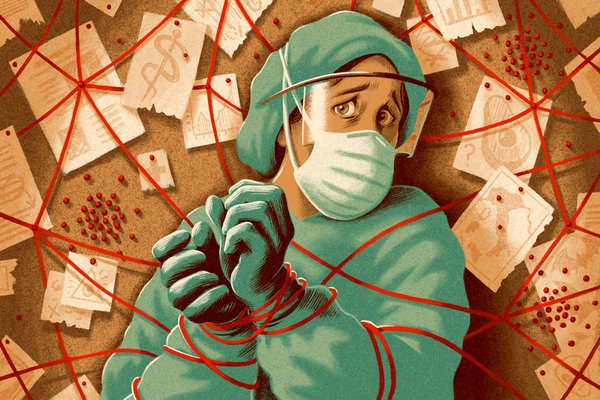The Corona threat is not of the level or gravity as we are given to understand and believe.
Thoughts of prospective troubles hardly come true. Most people die of visceral fear of spectre or something that doesn’t exist. “90% of our problems are caused by our own thoughts” says Hilda de la Rosa, a South African motivational speaker. She says, entrapped in our thought processes, we find it arduous to extricate ourselves from the thinking pattern we have imbibed over years. Unaware of the facts about morbidity and mortality due to Covid or otherwise, most people are caught with the fear psychosis that is taking larger toll than the pandemic itself lingering since March 2020. The predicament has shaken people of all description. The issue is certainly there but more is the hype. The pandemic 2.0 is particularly hitting Indians with greater intensity and virulence, yet a sensible and broader perspective can assure that the implications of the current crisis are not as dismal as we are being given to understand.
Certain mystery shrouds the resurgent Covid 2.0 with new strains. True, the plateauing of Covid cases in India by last fall led to public and government complacence about continuing risks. Considering relaxed national and social ethos by February this year the government toned down Covid restrictions. As the going seemed manageable, shops, restaurants, whole sale & retail markets, malls, schools, public transport, businesses and public establishments tended to function normatively. Export of jet fighters, plans to lay 75,000+ stations to charge electric vehicles, supply of domestically produced Covid vaccine to 87 countries and medicines to over 150 countries meant progression towards a vibrant economy and making of Atm Nirbhar nation. Naturally, the Indian buoyancy and optimism was not palatable to arms, oil, and pharma lobbies, as they could lose huge businesses in India; apropos of 5 billion dollar PPE and masks deal alone that came to naught in one shot, oil companies were next. Modi, who repeatedly said and meant ‘desh nahi lutne dunga, desh nahin bikne dunga’ was a common enemy who would not bend like Trump of USA. For the global business magnets to flourish in India, Modi’s downsizing if not ouster, with the aid of domestic disgruntled elements appeared as only option. To support was neighbouring China. Possibility of China-sponsored biological war in abrupt raise in Covid cases in India bypassing the neighbouring countries with identical life style during 10-15 April cannot be ruled out. Orchestrated to it was the opposition’s refrain of failure of Mody and his government to deal with Covid, enthusiastically supported by Western media. On 20 April, international media appeared in India to show the ‘large scale’ cremations and deficiencies in Indian health care sector. Strangely at this hour Pakistan also offered to help India. The anti-government chorus was endorsed by UNICEF executive director Henrietta Fore on 4 May, “The tragic situation in India should raise alarm bells for all of us”. Most recent in this context is the editorial in the medical journal Lancet summarily undermining the government’s efforts in dealing with Covid. The vindictive wording, “Mody’s actions in attempting to stifle criticism and open discussion during the crisis crisis are inexcusable”. The statement suggesting the government “owning up to its mistakes” is overtly that of a hardcore political adversary in bad taste, unbecoming of medical perspective. Reports on Chinese instigation behind the sordid coverage observations on India’s handling of Covid shall be revalatory.
At home, earlier in Covid 1.0 period the opposition decried lockdowns for its adverse implications on livelihoods. In second wave, after states were allowed to decide at their own level, they chose lockdown. They also criticised the efficacy of vaccine, then took it one by one. The purpose was creating a public impression that government is uwilling and misfit to manage Covid crisis, something not in national interest.
Ambiguity in identifying the precise aetiology, genesis and manifestations of Covid 2.0 further tends to destabilise the poise of lay public. The doctors find it expedient to classify routine health issues as Covid in keeping with trend. One head of a highly prestigious health facility at Medanta, Gurugram Dr. Arvind Kumar advised: consider any one of symptoms like sneezing, headache, fever, throat soar, vomitting, diarrhoea, loss of smell or taste, skin patches, body ache as Covid case unless proved otherwise, and begin with self-isolation without wait for lab reports – even negative reports with either symptom must be treated as Covid. Such precepts further down the already diminishing morale of the patient and his kith & kin that needs bolstering in the nerve breaking era we are passing through.
As for number game in Covid, national morbidity and mortality data on Covid across states in a specific time frames are subject to wide fluctuations because transmission of Covid is multifactorial in nature involving vision of the government, strict measures it takes and implements to control the pandemic including health facilities in place. Thus it shall be naïve to pronounce judgement on the performance of the governance based on infections and death data of few days, weeks or even months; policies and actions take long to show results. Taking the Covid data of 28 April 2021, though numerically India witnessed largest daily deaths (3647) among USA (954), Germany (320), France (344) and Italy (344) yet the deaths per crore population turns out to be mere 26 for India and 29, 38, 48 and 57 respectively for these countries (source: worldometers.info). Thus the narrative that India is worst hit by Covid smacks of foul play to tarnish the image of India.
Doctors are not know-all in health matters but in few weeks beginning Corana phase 2, how do they presume that all non-Corona diseases have eclipsed altogether. Based on 2017 data, World Economic Forum analysis revealed 25,270 daily deaths in India, second to China at 28,036. The estimated global annual death toll for tuberculosis of all kinds in 2019 stood at 14.18 lakh and 79,144 in India; for HIV-related diseases the annual death toll was 5 to 9 lakh global and 69,000 for India in 2017. These figures shall not be significantly different for 2020 and 2021. A fair, comparative assessment of quantitative change in morbidity & mortality in pre-Covid and Covid phases over a time frame brings to fore that the Covid death toll as reported is misleading and eclipses mortality from classical diseases. The actual Covid toll is not of the level we are told to make out.
The fear against Covid is largely visceral. It is the spectre of Covid that is real threat, and not the virus itself. Virus with a life of around seven days is an issue only in about 3 to 5 per cent cases where specialist handling is required. We are undergoing times when each section of country has to lend a helping hand. Let us face the facts squarely, keep our peace and hope for the best.
………………………………………………………
First published in The Pioneer on 17 May 2021, Monday under the heading ‘Corona: Some real though some hype. Link: https://www.dailypioneer.com/2021/columnists/corona–some-real–though-some-hype.html
…………………..………………………………………





An eye-opening, logically supported write up. However there is a terror around because of misinformation and maltreatment. It is hoped that things will improve with the dissemination of right information to the target audience and valuable inputs like that of yours.
Yes. Very true.
उचित ही लिखा है. परंतु जब तक आप जैसे लेखक इस तथ्य को उजागर नहीं करते, लोग भुगतते रहेंगे. आशा है, ऐसे लेखों से अनेक लोग लाभान्वित होंगे. JP Dhaundiyal